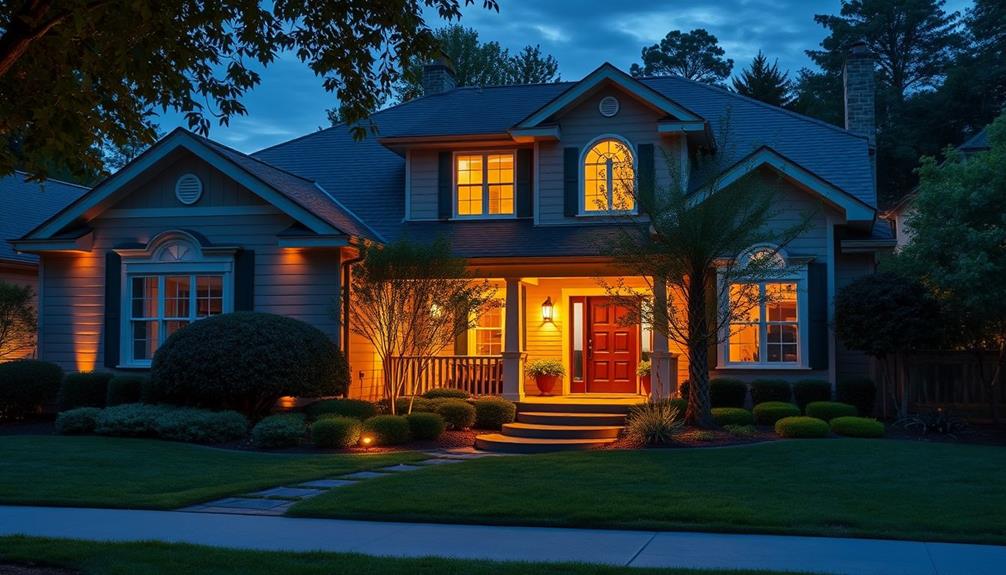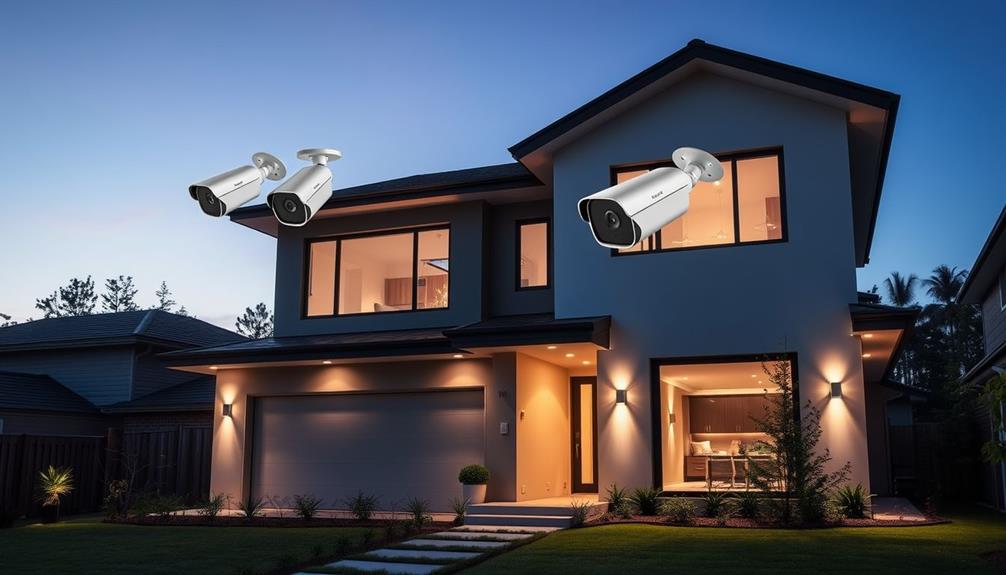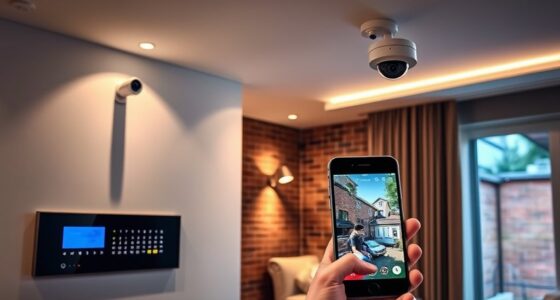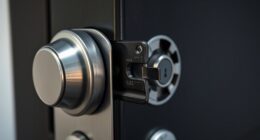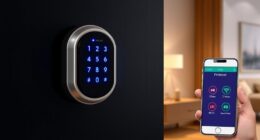In order to create a home security system, the first step is to assess your specific requirements. Identify any vulnerable entry points and take into account the crime rates in your area. Choose dependable devices such as security cameras, smart locks, and motion sensors. Determine whether you prefer self-monitoring or professional monitoring services. Select products that align with your budget and ensure they can be seamlessly integrated with your existing smart home devices. Safeguard the wiring and strategically position sensors for optimal coverage. Lastly, maintenance is crucial for a fully operational system. There is much more to explore regarding selecting the appropriate components and configuration to boost your security.
Key Takeaways
- Assess your home layout and neighborhood crime rates to identify vulnerable entry points needing protection.
- Choose between self-monitoring and professional monitoring based on your comfort level and budget.
- Invest in essential security devices like cameras, smart locks, and motion sensors for comprehensive coverage.
- Ensure your devices are compatible with smart home systems for enhanced automation and control.
Assessing Your Security Needs
When evaluating your security needs, start by examining your home's layout to pinpoint vulnerable entry points like doors and windows.
Look closely at areas such as garages and basements that might need extra protection. Consider the crime rate in your neighborhood; if you live in a high-crime area, you might want to invest in more extensive home security systems to deter potential intruders.
Additionally, installing reliable garage door openers can enhance security by preventing unauthorized access through these entry points.
Next, identify specific concerns you have about your property. If you own valuable items, have children or pets, or want to keep an eye on outdoor spaces, you'll need a system that addresses these issues.
Evaluating your security needs also involves reviewing your lifestyle. If you travel frequently, you might prioritize monitoring capabilities that allow you to check in remotely.
Decide whether you prefer a DIY home security system for its flexibility and cost savings or a professionally monitored service that can provide extra support during emergencies.
This decision will greatly impact how you approach securing your home.
Choosing a DIY Security System

When you're choosing a DIY security system, you need to think about the type of system that best fits your lifestyle, whether it's self-monitoring or professional monitoring.
Consider researching the return policies for electronics to guarantee that you can easily exchange any equipment that doesn't meet your needs.
You'll also want to identify the essential components you need while keeping your budget in mind.
System Type Selection
Choosing a DIY security system involves deciding between self-monitoring for hands-on control or professional monitoring for added reassurance. With self-monitoring, you manage alerts and notifications directly, giving you more control over your security. However, if you prefer peace of mind, opting for a system with professional monitoring might be the better choice.
To enhance your security setup, consider incorporating essential kitchen gadgets that provide additional safety features, such as smart devices that can alert you to unusual activity.
When it comes to system type selection, you should evaluate your specific security needs. Consider the number of entry points and the desired coverage area to determine which components, like cameras and sensors, you'll need.
Wireless DIY systems offer easy installation and flexibility, making them a great option if you anticipate modifications or expansions in the future.
Additionally, verify your chosen system is compatible with existing smart home devices. Many DIY systems integrate seamlessly with platforms like Alexa or Google Home, enhancing functionality and convenience.
Most DIY security systems are designed for user-friendly installation, so you won't need professional installation assistance. By carefully considering these factors, you can select the ideal DIY security system that fits your lifestyle and security requirements.
Essential Security Components
To create an effective DIY security system, prioritize essential components that enhance both safety and convenience in your home. Reflect on the importance of an all-encompassing cleaning routine for your space, as a clean environment can improve the efficacy of your security measures, ensuring that devices like best vacuum expert can function at their best without obstructions.
Start by selecting reliable home security devices that are compatible with each other and can be expanded later. Here are three key components to contemplate:
- Security Cameras: Opt for cameras with at least 1080p resolution for clear video monitoring both inside and outside your home. Floodlight cameras can offer additional benefits with built-in LED illumination and motion sensors for nighttime security.
- Smart Sensors: Incorporate smart sensors like motion detectors and water leak sensors. These devices provide thorough monitoring and immediate alerts for unusual activity or potential hazards.
Budget Considerations
Budgeting for a DIY security system requires careful consideration of initial costs, ongoing fees, and potential add-ons to guarantee you get the best value for your investment.
When you start planning, you'll find that initial costs typically range from $200 to $1,500, depending on the complexity and components you choose. For budget-conscious homeowners, basic starter kits, like those from SimpliSafe, can begin around $192, making them an accessible option.
Additionally, consider incorporating weather-resistant materials for outdoor elements of your security system to enhance durability and performance.
Don't forget to factor in monthly monitoring fees, which can vary from $10 to $50 based on the services you select. These fees enhance your security features and provide real-time alerts, making them worth considering.
While investing in quality products may mean higher upfront costs, it can lead to long-term savings by minimizing the need for frequent replacements or additional purchases.
Also, keep in mind potential add-on costs for extra sensors, cameras, or smart home integrations. These factors can greatly impact your overall budget.
Essential Security Components

When building your home security system, it's vital to identify key security devices that fit your needs.
This includes understanding the economic impact of niche markets in security technology, as well as considering innovative tools that enhance your system's effectiveness.
adaptive SEO approaches for seamless control and explore **budget-friendly options** that don’t compromise safety.Let's break down these essential components to help you create an effective and affordable security setup.
Key Security Devices
A solid home security system relies on key devices that work together to protect your property and loved ones effectively. To maximize your security, consider incorporating the following essential components:
Proper insulation, much like that which enhances heat pump efficiency, can help create a more secure environment by minimizing vulnerabilities. Additionally, regular maintenance of your security devices guarantees they're always ready to respond in case of an emergency.
- Security Cameras: These are fundamental for monitoring both indoor and outdoor areas. Aim for a resolution of at least 1080p for clear video quality. Models like the Eufy Indoor Cam 2K and Wyze Cam V3 are excellent choices.
- Smart Locks: Control access to your home with smart locks such as the Kwikset Halo Touch. They offer remote control capabilities via Wi-Fi, enhancing both convenience and security.
Additionally, don't overlook environmental sensors like the Flo by Moen Smart Water Detector, which can alert you to leaks, and smoke and carbon monoxide detectors for thorough safety.
Smart Home Integration
Smart home integration enhances your security system by allowing devices like cameras, locks, and sensors to communicate seamlessly, boosting both functionality and convenience.
By incorporating smart home products, you can create a cohesive network that elevates your home monitoring experience. For instance, systems like Ring and Abode work effortlessly with platforms such as Amazon Alexa and Google Home, letting you control your security features with simple voice commands.
With smart devices connected, you can receive real-time mobile alerts and notifications, keeping you informed about your property's status even when you're away. Many modern security cameras, like the Eufy Indoor Cam and Wyze Cam, are designed to integrate with your existing smart home ecosystem, ensuring smooth operation alongside other devices.
Automation features play an essential role in enhancing your security. Imagine your lights turning on automatically when motion is detected, not only increasing safety but also improving livability.
Budget-Friendly Options
Investing in essential security components can greatly enhance your home's safety without draining your wallet. You don't need to spend a fortune to create a secure environment. Start with these budget-friendly options:
- Door/window sensors and a motion detector can often be purchased as kits for under $100, providing a cost-effective way to enhance security.
- Consider budget-friendly security cameras like the Wyze Cam V3, which offers 1080p resolution at around $35, perfect for monitoring key areas in your home.
Additionally, the Kangaroo Motion + Entry Sensor is a smart option for around $30, alerting you to unusual activity.
For outdoor security, the Wyze Cam Floodlight provides both illumination and surveillance for under $50.
Installation and Wiring Tips

When setting up your home security system, choosing the right wire types is essential for ensuring reliable connections and effective performance. For connecting door and window contacts, use 22-2 or 18-2 wire. These options provide reliable signal transmission and are compatible with most alarm systems.
For keypads, glass break sensors, or motion detectors, opt for 22-4 or 18-4 wire. This wiring accommodates multiple connections while maintaining the integrity of your security system. Additionally, run 18-4 wire to siren locations, ensuring effective alarm sound delivery and strategic positioning for maximum coverage.
Don't forget to pull at least one CAT6 wire to your internet and telco demarc location. This step facilitates strong network connectivity for any IP cameras or smart devices you plan to integrate into your system.
Lastly, protect all wiring in conduits to prevent damage and allow for future modifications. Proper installation and wiring will enhance the longevity and reliability of your home security system, providing peace of mind that your home is well-protected.
Smart Home Integration

Integrating your home security system with smart devices boosts its effectiveness and convenience, allowing you to control everything from cameras to locks with ease. By utilizing DIY smart security solutions, you can create integrated systems that fit your lifestyle perfectly.
Here are some key benefits of smart home integration:
- Remote Monitoring: Keep an eye on your property from anywhere using your smartphone.
- Mobile Alerts: Receive instant notifications about potential security threats, guaranteeing you're always informed.
With popular smart home ecosystems like Amazon Alexa and Google Assistant, setting up your security devices becomes a breeze. These platforms allow for voice control and automation, enhancing your user experience.
Additionally, integrating smart sensors for smoke or flooding detection guarantees thorough protection.
By streamlining your home security setup, you'll not only boost safety but also enjoy the peace of mind that comes with knowing your home is well-protected.
Embrace the power of smart home technology—it's an investment in your safety and convenience.
Monitoring Options

Choosing the right monitoring option for your home security system can greatly impact how effectively you protect your property. You typically have two main choices: professional monitoring and self-monitoring. Each option has its pros and cons, so it's important to reflect on what works best for your lifestyle.
| Monitoring Option | Description |
|---|---|
| Professional Monitoring | 24/7 surveillance for a monthly fee, starting around $14.99. |
| Self-Monitoring | Alerts sent directly to your smartphone, offering flexibility without ongoing costs. |
| Smart Home Integration | Connects your security system with other smart devices for automated alerts. |
| No Long-Term Contracts | Services like SimpliSafe allow you to opt-in or out as needed. |
| Real-Time Alerts | Both options can provide immediate notifications, enhancing your response time. |
With professional monitoring, you benefit from constant surveillance, while self-monitoring gives you more control. Reflect on incorporating smart home integration for added convenience, allowing you to manage alerts and notifications seamlessly. Whichever you choose, the right monitoring option is vital for maintaining your home's security.
Product Recommendations

To effectively secure your home, consider investing in top-rated products tailored to meet your specific needs.
A solid home security system combines both indoor and outdoor security features, ensuring your property is well-protected. Here are some recommendations:
- Ring Alarm Kit (2nd-gen): Priced around $250, it includes a base station, keypad, and sensors, plus compatibility with Alexa for added convenience.
- Eufy Indoor Cam 2K: Offering clear 1080p resolution, this camera is perfect for video storage and works seamlessly with smart devices.
If you're into smart home technology, the Abode Smart Security Kit is a great choice at $220, supporting various devices, including smart doors.
Additionally, the SimpliSafe Home Security system, starting at approximately $192, allows for customization without long-term contracts.
Maintenance and Upgrades

Maintaining and upgrading your home security system is essential for guaranteeing it continues to protect your property effectively. Regularly test all components, including cameras, sensors, and alarms, to confirm they're working correctly. Don't forget to replace batteries in wireless devices as needed; this simple maintenance step helps maintain peak performance.
Schedule firmware updates for your security devices to safeguard against vulnerabilities. Manufacturers often release patches that enhance system security and improve features. Keeping an inventory of your system's components, including the make and model, streamlines troubleshooting and upgrades when new technology becomes available.
As you consider upgrades, think about expanding your system with innovations like smart home integration or AI-driven sensors to enhance functionality and overall security coverage. Additionally, review your monitoring plan annually. Make sure it aligns with your current security needs, adjusting the level of monitoring or adding new features based on changes in your home environment or lifestyle.
Frequently Asked Questions
Can You Build Your Own Home Security System?
Yes, you can absolutely build your own home security system. With a variety of DIY components available, you'll customize it to fit your needs and budget, ensuring you have the right protection for your home.
Is DIY Home Security Worth It?
In this modern age, DIY home security is definitely worth it. You can save money, customize your setup, and enjoy user-friendly installation. With effective protection, you'll feel safer without breaking the bank. It's a wise choice!
What Is the Easiest Home Security System to Setup?
If you're looking for the easiest home security system to set up, consider the Ring Alarm Kit or SimpliSafe. Both offer quick installation, wireless components, and user-friendly apps, making monitoring and management a breeze.
Are DIY Burglar Alarms Any Good?
Imagine sleeping soundly, knowing your home's secure. DIY burglar alarms are effective, customizable, and affordable. With options like motion detectors and cameras, they greatly reduce break-in chances, giving you peace of mind without breaking the bank.
What Are the Essential Components of a Home Security System?
When it comes to designing a home security system, there are a few essential components to consider. These include reliable door and window sensors, motion detectors, a high-decibel alarm, surveillance cameras, and a 24/7 monitoring service. These components work together to create a comprehensive security solution for your home.
Conclusion
Building a home security system is like crafting a protective shield around your sanctuary.
By understanding your needs and choosing the right components, you create a stronghold against potential threats.
As you integrate smart technology and explore monitoring options, you're not just safeguarding your space; you're fostering peace of mind.
Remember, regular maintenance keeps your fortress strong.
Embrace this journey, and let your home become a beacon of safety in an unpredictable world.



